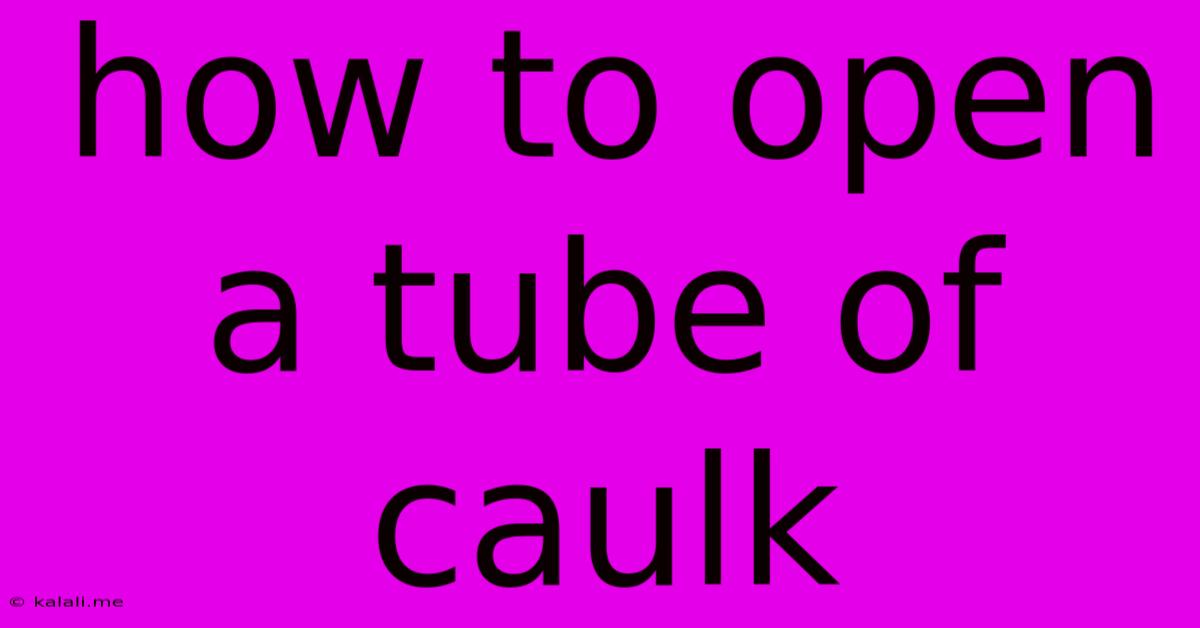How To Open A Tube Of Caulk
Kalali
Jun 02, 2025 · 3 min read

Table of Contents
How to Open a Tube of Caulk: A Step-by-Step Guide
Opening a tube of caulk might seem simple, but a frustrating struggle can easily ensue if you don't know the right technique. This seemingly mundane task can lead to messy spills, wasted caulk, and even injuries if you're not careful. This guide provides a comprehensive, step-by-step approach to opening a caulk tube efficiently and safely, preventing those frustrating moments and ensuring a smooth project start.
Understanding Caulk Tube Types and Mechanisms
Before we delve into the process, it's helpful to understand the different types of caulk tubes and their opening mechanisms. Most caulk comes in either a standard foil-sealed tube or a pressurized tube with a nozzle already attached. Both require slightly different approaches.
Opening a Standard Foil-Sealed Caulk Tube
This is the most common type. The process involves piercing the sealed foil and then preparing the tube for use. Here’s how:
-
Locate the Seal: The foil seal is typically at the end of the tube, under a small plastic cap. Remove this plastic cap.
-
Pierce the Seal: Use a sharp object, like a utility knife, box cutter, or even a strong pair of scissors, to carefully pierce the foil seal. Avoid cutting too deep—you only need to create a small opening. A small, controlled puncture is key to avoiding wasted caulk.
-
Prepare the Nozzle: Most tubes require you to attach a nozzle. Cut the tip of the tube at the angle specified on the instructions—usually 45 degrees is recommended for most applications. This creates a smooth flow of caulk.
-
Insert the Nozzle: Securely screw or attach the nozzle to the tube opening.
Opening a Pressurized Caulk Tube with a Pre-Attached Nozzle
These tubes often come with a pre-attached nozzle, simplifying the process somewhat.
-
Check the Nozzle: Ensure the nozzle is securely attached and not clogged.
-
Pierce the Seal: Some pressurized tubes have a small foil seal under a protective cap that needs to be pierced. Others might have a built-in piercing mechanism that is activated by pressing the trigger the first time.
-
Test the Flow: Before you start caulking, always test the flow on a scrap piece of material to ensure the caulk comes out smoothly and at the desired consistency. Adjust the nozzle tip as needed to control the bead size.
Essential Tips for a Smooth Experience
-
Use the Right Tools: Using a sharp knife or scissors is crucial to a clean and efficient puncture. Dull tools can damage the tube and cause frustrating spills.
-
Work in a Controlled Environment: Open the tube over a clean surface, such as a drop cloth or a piece of cardboard. This will prevent accidental spills and make cleanup easier.
-
Proper Disposal: After you've finished using the caulk, remember to dispose of the empty tube responsibly according to local recycling guidelines.
Troubleshooting Common Problems
-
Clogged Nozzle: If the caulk won't come out, the nozzle might be clogged. Try cleaning it with a thin wire or needle.
-
Uneven Bead: An uneven bead usually results from incorrect nozzle angle or excessive pressure. Practice on scrap material to get the hang of it.
-
Caulk Too Thick: If the caulk is too thick, try gently warming the tube in warm water (not hot water). This can help to improve its consistency.
By following these steps and tips, you'll be able to open a caulk tube with ease, avoiding frustration and ensuring a successful caulking project. Remember to always prioritize safety and work in a clean, organized area for best results.
Latest Posts
Latest Posts
-
Engineering Vehicle Gear Sales Manufacturer How Much
Jun 04, 2025
-
How To Get Rid Of Kitchen Sink Smell
Jun 04, 2025
-
What Does The Bible Say About Calling Someone A Fool
Jun 04, 2025
-
Can Items Despawn If Your Far In Minecraft
Jun 04, 2025
-
Smoke Coming Out Of Ac Vents In Car
Jun 04, 2025
Related Post
Thank you for visiting our website which covers about How To Open A Tube Of Caulk . We hope the information provided has been useful to you. Feel free to contact us if you have any questions or need further assistance. See you next time and don't miss to bookmark.